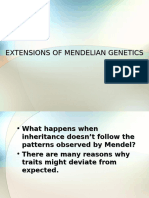0 ratings0% found this document useful (0 votes)
37 views4 Leathel Alleles
Uploaded by
Batool AshrafCopyright
© © All Rights Reserved
Available Formats
Download as PDF or read online on Scribd
0 ratings0% found this document useful (0 votes)
37 views4 Leathel Alleles
Uploaded by
Batool AshrafCopyright
© © All Rights Reserved
Available Formats
Download as PDF or read online on Scribd
You are on page 1/ 20
What are Lethal alleles?
— Definition
* Genes which result in viability reduction of
individual or become a cause for death of
individuals carrying them.
* Some lethal genes cause death of zygote or
the early embryonic stage while some express
their effect in later stages of development.
Types of lethal alleles
* Lethal alleles falls into four categories.
1. Early onset- lethal alleles which result in death of an organism at
early stage of life for example during embryogenesis
2. Late onset- lethal allele which kills organism at their final stage of
life are known as late onset allele
3. Conditional- lethal allele which kill organism under certain
environmental conditions only.
e.g., temperature sensitive alleles kills organism at high
temperature. But they don’t kill any organism at low temperature.
Cont..
4. Semi lethal — Lethal allele which kill only some individuals of
the population but not all are know as semi lethal.
Certain genes are absolutely essential for survival. Mutation in
these genes creates lethal allele
Lethal alleles are dominant or recessive
Fully dominant lethal allele kills organism in both
homozy gous and heterozygous condition
Certain lethal alleles kills organisms in homozygous condition
only.
History
Lethal genes were first discovered by Lucien Cuénot while
studying the inheritance of coat colour in mice.
He expected a phenotype ratio from a cross of 3 yellow:1 white,
but the observed ratio was 2:1.
Allele was lethal in homozygous dominant condition
* ~Cuénot thus determined that yellow coat color was
the dominant phenotypic trait, and by using test crosses, he showed that
all his yellow mice were heterozygotes. However, from his many crosses,
Cuénot never produced a single homozygous yellow mouse.
* How could this be?
P generation
Yellow
Shortly thereafter, in 1910, W. E. Castle and C. C. Little confirmed
Cuénot's unusual segregation ratios .
Moreover, they demonstrated that Cuénot's crosses resulted in
what appeared to be non-Mendelian ratios because he had
discovered a lethal gene.
Castle and Little did this by showing that one-quarter of the
offspring from crosses between heterozygotes died during
embryonic development .
This was why Cuénot never observed homozygous yellow mice!
Thus, by considering embryonic lethality, or death, as a new
phenotypic class, the classic 1:2:1 Mendelian ratio of genotypes
could be reestablished
¢ As this examples illustrate, lethal genes cause the
death of the organisms that carry them.
* Sometimes, death is not immediate; it may even
take years, depending on the gene.
* In any case, if a mutation results in lethality, then
this is indicative that the affected gene has a
fundamental function in the growth,
development, and survival of an organism.
Types of lethal genes
Recessive Lethal Genes
Cuénot and Baur discovered these first recessive lethal
genes because they altered Mendelian inheritance ratios.
Recessive lethal genes can code for either dominant or
recessive traits, but they do not actually cause death unless
an organism carries two copies of the lethal allele.
Examples of human diseases caused by recessive
lethal alleles include cystic fibrosis, sickle-cell anemia, and
achondroplasia
¢ Achondroplasia is an autosomal dominant bone
disorder that causes dwarfism. While the inheritance
of one achondroplasia allele can cause the disease,
the inheritance of two recessive lethal alleles is fatal.
* Dominant Lethal Genes
Dominant lethal genes are expressed in both
homozygotes and heterozygotes. But how can
alleles like this be passed from one generation to
the next if they cause death?
Dominant lethal genes are rarely detected due to
their rapid elimination from populations. One
example of a disease caused by a dominant lethal
allele is Huntington's disease
* Huntington's disease
* a neurological disorder in humans, which reduces
life expectancy.
¢ Because the onset of Huntington's disease is
slow, individuals carrying the allele can pass it on
to their offspring. This allows the allele to be
maintained in the population. Dominant traits
can also be maintained in the population through
recurrent mutations .
Huntington's Disease
Allele D d Allele
Genotypes
DD Dd and dD dd
Homozygous Heterozygous Homozygous
Phenotypes Affected Unaffected
Dominant Recessive
Conditional Lethal Genes
* an organism lives normally under one set of conditions, but
when certain changes are introduced in its environment,
lethality results.
* Favism is a sex-linked, inherited condition that results from
deficiency in an enzyme called glucose-6-phosphate
dehydrogenase.
* Itis most common among people of Mediterranean, African,
Southeast Asian, and Sephardic Jewish descent .
* The disease was named because when affected individuals
eat fava beans, they develop hemolytic anemia, a condition in
which red blood cells break apart and block blood vessels.
* Blockage can cause kidney failure and result in death
Sex-Linked Lethal Genes
* Semilethal or Sublethal Genes
* the lethal gene is carried on the sex chromosome, usually X.
* Hemophilia is a hereditary disease caused by deficiencies in clotting
factors, which results in impaired blood clotting and coagulation.
* Because the allele responsible for hemophilia is carried on the
X chromosome, affected individuals are predominantly males, and
they inherit the allele from their mothers.
* The alleles responsible for “Carter” bhother ana Femmes Withont Hemephitia
hemophilia are thus called
semilethal or sublethal genes,
because they cause the death i. >
of only some of the individuals
or organisms with the ee inrenn
Se, oe,
i ot @
Daughter Daughter
{camer for te (does not carry
hemophita) hesaphin gene) menace seas gene)
xY
affected genotype.
Children
* Normally, clotting factors help form a temporary scab after a
blood vessel is injured to prevent bleeding, but hemophiliacs
cannot heal properly after injuries because of their low levels
of blood clotting factors.
* Therefore, affected individuals bleed for a longer period of
time until clotting occurs. This means that normally minor
wounds can be fatal in a person with hemophilia.
pt
ioe
an |
Synthetic Lethal Genes
¢ When an allele causes lethality, this is evidence that the
gene must have a critical function in an organism.
* The discoveries of many lethal alleles have provided
information on the functions of genes during
development.
* So scientists used conditional and synthetic lethal alleles
to study the physiological functions and relationships of
genes under specific conditions.
You might also like
- Modification of Mendelian Ratio II - Lethal Mutations & Epistasis (2 HRS) 2011No ratings yetModification of Mendelian Ratio II - Lethal Mutations & Epistasis (2 HRS) 201135 pages
- Lethal Genes AND Gene Therapy: by Anila and PoojaNo ratings yetLethal Genes AND Gene Therapy: by Anila and Pooja67 pages
- Non-Mendelian Pattern of Inheritance: Prepared By: Ms. Angielyn G. ArandaNo ratings yetNon-Mendelian Pattern of Inheritance: Prepared By: Ms. Angielyn G. Aranda24 pages
- (Lec4 Genetic (Lethal Alleles and Multiple AllelesNo ratings yet(Lec4 Genetic (Lethal Alleles and Multiple Alleles18 pages
- Chap2 Latest Extensionofmendeliangenetics 120919212840 Phpapp01No ratings yetChap2 Latest Extensionofmendeliangenetics 120919212840 Phpapp0187 pages
- 5 Human Diseases, Causes and Reasons (Lec IV)No ratings yet5 Human Diseases, Causes and Reasons (Lec IV)28 pages
- Recessive Lethal Alleles Result in Homozygous Recessive Individuals That Don't SurviveNo ratings yetRecessive Lethal Alleles Result in Homozygous Recessive Individuals That Don't Survive30 pages
- Modifications To Mendel's Classic Ratio. GenBio 2No ratings yetModifications To Mendel's Classic Ratio. GenBio 220 pages
- Exceptions To Mendel's Laws:: Co-Dominance Incomplete Dominance Multiple Alleles Lethal GenesNo ratings yetExceptions To Mendel's Laws:: Co-Dominance Incomplete Dominance Multiple Alleles Lethal Genes19 pages
- Lesson 5 - Exceptions & Extensions To MendelianNo ratings yetLesson 5 - Exceptions & Extensions To Mendelian26 pages
- History of Genetics and Genetic Disorders - Prof. MohammedaniNo ratings yetHistory of Genetics and Genetic Disorders - Prof. Mohammedani47 pages
- Extension of Mendelian Genetics Non Mendelian GeneticsNo ratings yetExtension of Mendelian Genetics Non Mendelian Genetics83 pages
- Chapter 4 - Extention To Mendelian GeneticsNo ratings yetChapter 4 - Extention To Mendelian Genetics48 pages
- What Are The Different Ways in Which A Genetic Condition Can Be Inherited?No ratings yetWhat Are The Different Ways in Which A Genetic Condition Can Be Inherited?4 pages
































































